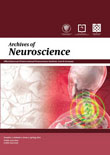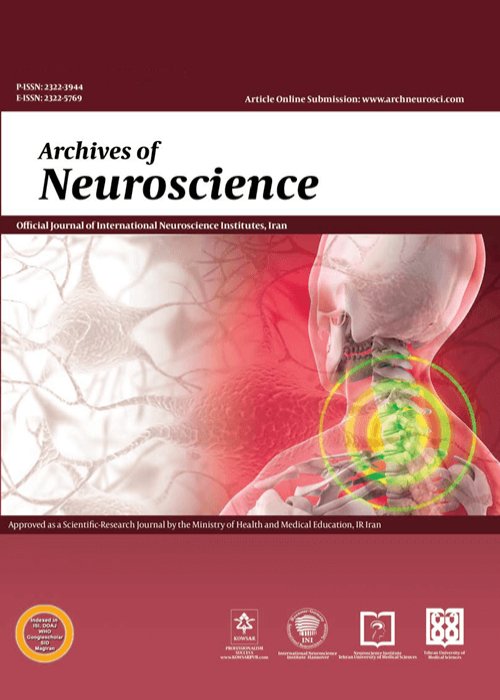فهرست مطالب

Archives of Neuroscience
Volume:2 Issue: 3, Jul 2015
- تاریخ انتشار: 1394/03/24
- تعداد عناوین: 8
-
-
Page 1BackgroundBlood loss during spinal decompression and fusion is high and at times more than the patient’s total estimated blood. Increased blood loss may increase the risks of morbidity and eventually length of hospital stay (LOS).ObjectivesThe aim of this study was to identify predictor factors of blood transfusion requirements and the length of hospital stay in adult patients who underwent lumbosacral surgery.Materials And MethodsThis was a multicenter cross-sectional study to predict factors of hospital length of stay (LOS) and intraoperative red cell transfusion in patients undergoing major posterior lumbar spinal surgeries. In this study, 298 patients who needed spinal surgery were enrolled.ResultsMultiple linear regression results revealed the following information. Among variables that had significant association with the volume of intraoperative blood loss, considerable predictors were the number of level fused (R2 = 0.42), mean intraoperative SBP (R2 = 0.22), length of operation (R2 = 0.31) and increasing age (R2 = 0.37). Significant predictors for the length of hospital stay were increasing age (R2 = 0.22), much more comorbid conditions (R2 = 0.30), operation length (R2 = 0.27), the number of level fused (R2 = 0.21) and the volume of intraoperative blood loss (R2 = O.29). The results of logistic regression revealed that length of operation, preoperative Hb value, number of level fused and mean intraoperative SBP considerably predicted the need for intraoperative blood transfusion.ConclusionsDiminishing intraoperative SBP could decrease intraoperative blood loss and eventually less red cell transfusion and shorter LOS. Besides, correcting preoperative anemia in female patients before elective surgeries could decrease a need for red cell transfusions and ultimately decreased red cell transfusion complication rate and shorter hospital LOS.Keywords: Surgery, Spine, Blood Transfusion, Blood
-
Page 2BackgroundParkinson’s disease (PD) is a neurodegenerative disorder characterized by pervasive motor deficits, often accompanied by specific cognitive impairments, most prominently executive dysfunctions. However, it is often hard to determine whether the impaired performance of patients with PD on executive tests is the result of an executive dysfunction or whether it is due to motor difficulties.ObjectivesThe present study aimed to examine the relationship between cognitive inflexibility, an executive dysfunction consistently found in PD, and motor deficiencies in patients with PD using derived scores, from a common executive function test named trail making test (TMT).Patients andMethodsFifty patients with PD and 50 demographically matched controls underwent neuropsychological examination which included TMT, part A and part B. Performance on each task was assessed and the following derived scores TMT B/A, TMT B-A/A, and TMT B-A were calculated and compared.ResultsMann-Whitney tests revealed significant group differences for the mean TMT A (P = 0.006) and TMT B (P = 0.000), which were both higher in the PD group, relative to controls. In addition, significant differences were found for one TMT product score (TMT B-A).ConclusionsThe results presented a significantly lower performance of patients with PD compared to controls, indicating the presence of a mental flexibility impairment which is dissociable and independent from the motor dysfunction.Keywords: Parkinson s Disease_Trail Making Test_Executive Function
-
Page 3Context: Review of epidemiological studies of different geographical regions show a wide variation in the prevalence of multiple sclerosis (MS) worldwide. This study compares related geoepidemiological differences in prevalence of MS in the Middle East. Evidence Acquisition: Key words relevant to “prevalence of multiple sclerosis” were searched for with countries in the Middle East.ResultsA prevalence of 31–55 per 100,000 individuals has been reported for Persian Gulf countries. The reported prevalence per Kuwait (n = 85.05) and United Arab Emirate (n = 54.4) seems to be high. The reported prevalence for Turkey and Jordan were 51 and 20, correspondingly. Within Iran, the highest and lowest prevalence seem to belong to Isfahan (n = 93.06) and Golestan (n = 18.0), respectively. Immunomodulating drugs such as Interferon-beta as a first-line therapy; and cyclophosphamide, methotrexate, mitoxantrone, and azathioprine have been considered as second-line therapies.ConclusionsThe high prevalence of MS in the Middle East might be pointed toward the adverse effects of low vitamin D, individual daily life, smoking, Epstein-Barr virus infection, hereditary affects, and a history of depression.Keywords: Middle East, Prevalence, Multiple Sclerosis
-
Page 4IntroductionPapillary carcinoma of the thyroid is the most common differentiated malignancy of thyroid, which is characterized by slow progression and a good prognosis. Being extremely rare, brain metastases from papillary thyroid carcinoma (PTC) have a poor prognosis; they are usually asymptomatic, but a few could be very symptomatic and life threatening.Case PresentationWe report a rare case of brain metastasis from PTC with sudden loss of consciousness and normal follow-up screening tests, 17 years after primary diagnosis of PTC. The patient underwent radical surgery urgently and the histopathologic diagnosis of metastatic brain tumor of thyroid papillary carcinoma was made. Postoperative course was uneventful, and the patient’s neurologic deficits improved.DiscussionAn early diagnosis and treatment of brain metastasis of PTC can result in longer survival time for patients and magnetic resonance imaging can be used as the most sensitive method for detecting brain metastases. The treatment modalities must be individualized and surgery could be a more suitable treatment option in case of hemorrhagic metastasis.Keywords: Brain, Metastasis, Thyroid Carcinoma
-
Page 5BackgroundApproximately, 3% of the world’s population have hyperhidrosis, a situation in which excessive sweating occurs in response to the need to regulate body temperature. Endoscopic devices have been used for treatment of this disease through sympathicotomy.ObjectivesThe aim of this study was to assess the effectiveness and adverse effects of endoscopic sympathicotomy in treatment of hyperhidrosis.Patients andMethodsWe enrolled 41 patients in the study. Ganglion disconnection was performed at T2 - T3 level for patients with palmar hyperhidrosis and at T3 - T4 level for patients with axillary hyperhidrosis. Patients were evaluated for successful response to surgical treatment, occurrence of reflex hyperhidrosis following surgery, and location of reflex hyperhidrosis at one week and at six months of surgery.ResultsAfter surgical treatment, 75.6% of patients reported complete response to treatment while 82.9% reported reflex hyperhidrosis after surgery. The frequency for moderate and severe sweating was 8.8% and 26.5%, respectively.ConclusionsSympathicotomy technique can be used in the treatment of primary hyperhidrosis in patients who did not respond to nonsurgical treatments; however, the incidence of reflex hyperhidrosis is of concern following surgical treatment.Keywords: Hyperhidrosis, Thoracoscopy, Ganglia
-
Page 6BackgroundAccording to the published articles, there is an increase in the prevalence of MS all over the world. Regarding demographic characteristics for unknown reasons, females are more affected than males.ObjectivesThe aim of this study was demographic analysis and model of changes in patients for three years in a local teaching hospital in Isfahan/Iran.Patients andMethodsIn total, 1500 patients with MS were studied within three Intervals (I) from; 1 - 2011/05/22 to 2012/03/18 called I1, 2- 2012/03/22 to 2013/03/19 called I2 and 3- 2013/03/22 to 2013/10/19 called I3. Data was recorded in Excel and analyzed using SPSS for windows.ResultsOf the total population studied, 75% were female. 32% and 33% of patients related to the age groups of 20 - 30 and 30 - 40 years, respectively. However the number of patients related to time interval I3 were 472, but there was an increase in the number of patients studied from I1 to I2 (394 vs. 634). Approximately 13% of total population had MS attack more than 4 to 19 times.ConclusionsIn agreement with previous reports, due to unknown reasons, the number of patients in general and the number of females in particular were increased annually. Within this population due to inter- and intra- individual variability, pharmacokinetic studies seem to be valuable.Keywords: Multiple Sclerosis, Demography, Pulse therapy, Drug
-
Page 7Context: Epilepsy is one of the most common serious neurological disorders. Antiepileptic drugs are effective in most of patients, but one third of them are poorly controlled or their seizures are refractory to drug treatment. Resective surgery is the most common form of surgical treatment for uncontrolled seizures, but it can be associated with profound complications that limit its use. Hence, alternative therapeutic options are required.Evidence Acquisition: Deep brain stimulation (DBS) is increasingly used for the treatment of neurological and psychiatric diseases in patients who do not respond to conventional treatment. Significant improvement of well-being (i.e. quality of life) has been observed in patients with Parkinson’s disease and obsessive compulsive disorder. As a result of these observations, DBS is now performed in small patient groups for the treatment of many disorders including epilepsy. However, despite its broad therapeutic potential, the appropriate targets for DBS are poorly understood and the application of DBS is most often based on case-reports rather than basic research derived from the laboratory. There are studies suggesting that intractable epileptic seizures can be modified or interrupted by electrical stimulation of subcortical structures including thalamic nuclei. In this review article, we focused on DBS in thalamus to highlight the recent developments and address the perspectives of this approach for the treatment of refractory epilepsy.ResultsAnterior and centromedian thalamic nuclei have a potential role in reducing seizure frequency, particularly in patients with partial and generalized tonic clonic seizures, respectively. Stimulus parameters, especially frequency is an essential factor in determination of the effects of stimulation. Moreover, bilateral stimulation of thalamic nuclei in most experimental and clinical studies appeared to be protective against the incidence of seizure.ConclusionsElectrical stimulation of anterior and centromedian thalamic nuclei represents a new alternative option in the treatment of patients with refractory epilepsy, particularly in those with partial and generalized tonic clonic seizures who are not candidates for surgery or do not respond to surgery. Although most studies suggest that bilateral high frequency stimulation of thalamic nuclei is effective in reducing seizure activity, further studies are required to determine optimal parameters and risk/benefit ratio of thalamic nuclei DBS for the treatment of intractable epilepsy.Keywords: Deep Brain Stimulation, Thalamic Nuclei, Epilepsy
-
Page 8BackgroundMultiple Sclerosis (MS) is an inflammatory demyelinating disease leading to formation of brain lesions that could produce numerous devastating clinical problems. There are controversial reports related to the type of association of MS with the seasons of birth.ObjectivesThis study aimed to rank and describe the effect of different months and days of birth on MS.Patients andMethodsThe study was conducted in Isfahan University of Medical Sciences, Isfahan, Iran. A total of 1484 patients with MS were included: 1111 females and 373 males. Demographic and clinical data were recorded in a database and were analyzed using SPSS.ResultsThe population of females with MS had surpassed that of males (75% vs. 25%). The mean age of patients was 34.7 years (range from 7 to 88 years) with 85% of population being younger than 50 years old. The season of birth was winter in 21% of patients. There was a decreased risk of MS in those born in February and March. The prevalence of MS increased from April and reached a peak in May and September. Day of birth was associated with the birthday on 19th day of month in 44% of patients.ConclusionsThis investigation supports earlier reports of increased and diminished prevalence of MS in those born in the spring and winter months, respectively. Pharmacotherapy using vitamin D might have beneficial effect in Iranian population, especially in females during pregnancy and their newborns. Therefore, further clinical researches focused on prescription of vitamin D, genetic, daily photoperiod, and geo-epidemiologic differences of disease are recommended.Keywords: Multiple Sclerosis, Seasons, Baby Delivery, Birth Timing


